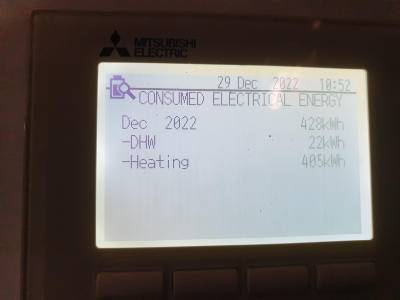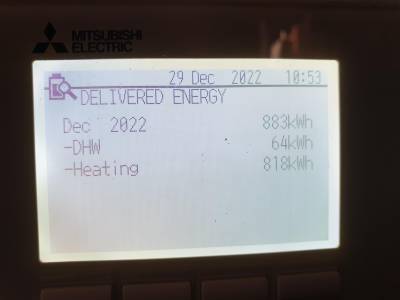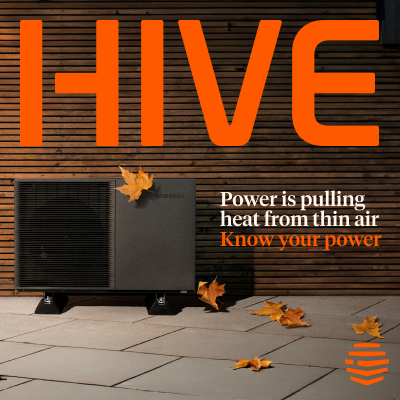Clarification needed for Ecodan ASHP settings
It may be useful if I explain a few things about how heat pump systems function and then you can decide how best to operate yours.
The heat pump gathers energy from both the electricity supply and the outside air. The warmer the outside air, the more energy it can provide, and hence less energy is required from the electricity supply.
When the outside air temperature is lower than the inside air temperature your home loses energy, as shown by the heat loss calculations, the colder the outside air temperature then the greater the heat loss.
To maintain a constant indoor temperature the heat pump needs to produce sufficient energy to match the heat loss, so as the outside air temperature gets colder the heat pump needs to work harder to produce more heat energy. The purpose of weather compensation is to try to match the heat energy produced by the heat pump to the heat loss of your home.
To keep your home at the desired temperature, the heat energy produced by the heat pump needs to be transferred to the heat emitters, your radiators and UFH. This is normally done by the water pump located inside your heat pump, but can also involved a further external water pump. Do you have an external water pump?
The amount of heat energy transferred from your heat emitters depends upon their size, and type, along with the temperature of the water being fed from the heat pump and the flow rate of that water. This is why most of the TRV's should be fully open to ensure adequate water flow. Since the size and type of heat emitters is fixed, the amount of heat energy is controlled by varying the water temperature and the water flow rate.
The setting of the weather compensation curve is used to vary the water temperature, and the heat pump controller varies the water flow rate by speeding up or slowing down the water pump.
If you require an upstairs temperature of 19C and a downstairs temperature of 15C, then I would expect your system to operate in the following manner. With your thermostat set at 21C and the TRV's fully open and your UFH set for 15C.
If the outside air temperature is 0C, then the heat pump should be warming the water to approximately 40C, as calculated by the weather compensation. If the downstairs temperature is below 15C then some of this warm water will be fed to the UFH pipework, until the temperature increases to 15C. If the upstairs temperature is below 21C then some of this warm water will be fed to the radiators. If the amount of heat energy coming from the radiators is greater than the heat loss, then the upstairs temperature will start to increase, but as the upstairs temperature rises then so will the heat loss. At some point the heat loss and energy supplied will balance and the upstairs temperature will remain constant.
If the upstairs temperature is above the desired 19C, the weather compensation setting is too high, but if the upstairs temperature is below 19C, then the weather compensation setting is too low.
What I would suggest in your situation is rather than lowering the weather compensation from 40C to 35C at an outside temperature of 0C, you should change the setting to 40C at an outside temperature of -5C. This will have the same effect of lowering the weather compensation curve, but will allow your system response to be maintained should the outside temperature fall to -5C.
By continuing to monitor the system, as you are doing, you should be able to fine tune your weather compensation curve until it closely matches the heat loss of your home. I would not suggest making any large changes and always allow time for the system to stabilise before making any further adjustments.
Thanks Derek - thats one of the best explanations Ive read!!
Funnily enough, changing the slope of the curve (as you suggested) was going to be my next thing to try.
Ill post back on here in a fortnight and give an update.
Cheers!
Hi, just thought Id give an update.
Its been quite a good time to test recently (not that Ive been testing particularly diligently or scientifically!) - we've had a temperatures ranging from -6c to 12c.
I currently have the comp curve set at -40c @ -5c outside, going down to 25c @ 15c outside. So far I feel this is about right for my rooms.
I open the TRVs fully in whatever room Im occupying. (Im either in my office for the most part, or in my bedroom). The stat is sat either in my office or bedroom. Its set to 20c, but it hardly ever gets to 20c so the heating is on all the time.
The Ecodan doesnt let me go below 25c, which got me thinking whether that was a safety feature. Is there any negatives to having the comp curve set as low as I have it? (cycling etc...)
I still cant get a COP better than ~2.1 (I never have, even when it was first installed 4 years ago!), so I dont know if Im reading the Ecodan incorrectly. I dont think I am becuase its a basic case of reading the Consumption and Delivered figure and dividing one by the other.
Cheers
Posted by: @tuftyHi, just thought Id give an update.
Its been quite a good time to test recently (not that Ive been testing particularly diligently or scientifically!) - we've had a temperatures ranging from -6c to 12c.
I currently have the comp curve set at -40c @ -5c outside, going down to 25c @ 15c outside. So far I feel this is about right for my rooms.
I open the TRVs fully in whatever room Im occupying. (Im either in my office for the most part, or in my bedroom). The stat is sat either in my office or bedroom. Its set to 20c, but it hardly ever gets to 20c so the heating is on all the time.
The Ecodan doesnt let me go below 25c, which got me thinking whether that was a safety feature. Is there any negatives to having the comp curve set as low as I have it? (cycling etc...)
I still cant get a COP better than ~2.1 (I never have, even when it was first installed 4 years ago!), so I don't know if Im reading the Ecodan incorrectly. I dont think I am becuase its a basic case of reading the Consumption and Delivered figure and dividing one by the other.
Cheers
Your curve looks fine if it works for you. You can change the flow temp settings; it's in Operation Settings - Heating Operation - Flow Temp Range. I think the minimum is 20.
Your COP still seems a bit low. Do you have a buffer, low loss header or similar? They can sometimes cause lower efficiency. Mine has never been that low and my flow temps are a bit higher than yours now.
How do I find out if I have a buffer, low loss header or similar? If I do have one, is it a case of turning it off?
Ive just taken a photo showing the Consumed/Delivered:
Consumed: 428kwh (22 HW; 405 Heating)
Delivered: 883kwh (64 HW; 818 Heating)
COP 2.06 overall (2.9 HW; 2.01 Heating)
Hot water has always had a COP of ~2.8, whereas Heating has never had a COP of more than ~2.2 .
Posted by: @kev-mYour curve looks fine if it works for you. You can change the flow temp settings; it's in Operation Settings - Heating Operation - Flow Temp Range. I think the minimum is 20.
Your COP still seems a bit low. Do you have a buffer, low loss header or similar? They can sometimes cause lower efficiency. Mine has never been that low and my flow temps are a bit higher than yours now.
Ive just dug out the gubbins the installers gave me and in the Material List they have "Low Loss Header for maximised efficiency, avoiding short cycling of ASHP". So I have got a Low Loss Header. Now I know this, is there something else I can do to try and get a better COP?
- 26 Forums
- 2,158 Topics
- 47.4 K Posts
- 26 Online
- 5,736 Members
Join Us!
Podcast Picks
Latest Posts
-

@editor thanks Mars. I've managed to find a phone numbe...
By bontwoody , 8 hours ago
-

@rhh1, I’ll contact Daikin’s brand manager tomorrow and...
By Mars , 8 hours ago
-
RE: Testing new controls/monitoring for Midea Clone ASHP
In a way I would like to agree with the final conclusio...
By JamesPa , 11 hours ago
-

RE: Big Changes Coming to Our Heat Pump System
Day one is done. The system’s been fully flushed and ...
By Mars , 12 hours ago
-

RE: Midea ASHP – how to set weather compensation
I noticed that too and thought the same thing, but then...
By cathodeRay , 14 hours ago
-

RE: Ya can’t win! It is S*d’s Law!
@old_scientist If IOF is still running next late spring...
By Toodles , 14 hours ago
-

RE: Electricity price predictions
Those of you on Agile will do well tomorrow; there are ...
By Toodles , 14 hours ago
-
RE: Who’s Caved and Switched the Heating On Already?
We've been running our Ecodan system, installed in June...
By Sheriff Fatman , 17 hours ago
-
Ok. Two schools of thought. The first is to run the ...
By JamesPa , 1 day ago
-
@drei Willing as I am to help, I don't think I'm yet ...
By JamesPa , 2 days ago
-
RE: Is Your Broadband Router the Weak Link in Your High-Tech Home?
I hear you on the locality issue @transparent, and I ag...
By Scalextrix , 2 days ago
-
Selling 5 year old ASHP & Gas Combi Boiler - £590
Selling a 5-year-old Daikin Altherma Hybrid Air Source ...
By Paul G , 2 days ago
-
RE: Help me keep the faith with my air source heat pump installation
Er true, it should have read l/hr!
By JamesPa , 2 days ago
-
RE: Is a Valliant Inline 6kW heater a BUS buster?
Much of that is true in principle, but its not likely t...
By JamesPa , 3 days ago
-
RE: Heat Pump Servicing & Maintenance – Good Value or Rip-Off?
@dgclimatecontrol I attach the responses from 2 potenti...
By pash44pump , 4 days ago
-
RE: Buffers, hot water and cooling
@dgclimatecontrol thanks, that's helpful.
By JamesPa , 4 days ago
-
RE: Failing heat pump system - seeking thoughts on a rebuild
I realise im overdue an update on my situation. first...
By Cleardene-ashp , 5 days ago
-

RE: Replacing Worcester oil boiler with an ASHP
@toodles thanks. I was told by the engineer that this h...
By JulianC , 5 days ago
-

RE: What crazy nonsense are inverter limits and why are they imposed?
A week later, I'm finally picking up this comment... ...
By Transparent , 5 days ago
Members Online
No online members at the moment






